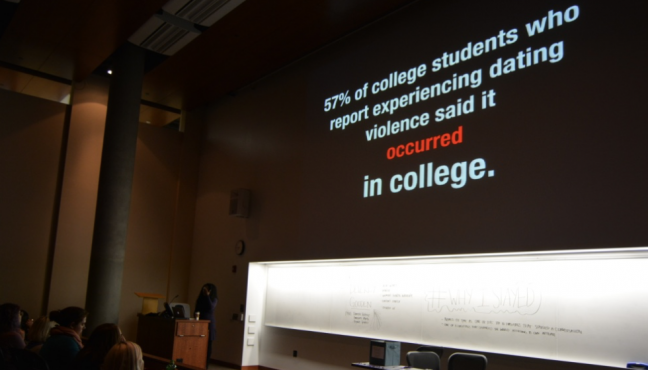Four years free of her own abusive relationship, Beverly Gooden took to Twitter to voice the reasons that made it difficult for her to leave such a situation.
Tacking on the hashtag #WhyIStayed, Gooden responded to the Twitter dialogue surrounding the 2014 arrest of NFL football player Ray Rice for domestic violence. The next thing she knew, #WhyIStayed was trending on Twitter. The hashtag was tweeted by more than 100,000 people within the first 24 hours.
In honor of Domestic Violence Awareness Month, student organizations Promoting Awareness Victim Empowerment, Illumination Magazine and the Campus Women’s Center co-hosted an event with Gooden as a keynote to open the conversation about abusive relationships Thursday evening.
In 2014, video footage of then-Baltimore-Ravens-running-back Rice physically assaulting his then-fiance was leaked, leading to his arrest.
When Gooden saw the Twitter responses to the video footage of Rice assaulting his partner, she noticed that all of the questions were pointed at the woman.
“No one was asking anything about his actions,” Gooden said. “People were asking ‘Why did she stay?’ when it should have been ‘Why did he abuse?'”
That’s what sparked her initial Tweets and the hashtag #WhyIStayed, which opened a national dialogue.
Now, Gooden’s voice goes beyond Twitter. She travels to college campuses, speaking out about the reasons why women stay in abusive relationships and the dangers of when they do.
It can sometimes be difficult, Gooden said, for a person to know they are living in a cycle of violence.
Initially, Gooden said there would be 28 good days in a month, a day of violence and then a day or two of reconciliation.
“The math is in their favor until 28 days turns into 20 days,” Gooden said. “And 20 days turns into 17 days, and 17 days turns into 14 days, and the math is up.”
Gooden said she ultimately made the decision to leave the relationship after her ex-partner pushed her out of bed while she was sleeping and followed her into the bathroom to choke her.
It took that instance to make her realize it wasn’t her: She wasn’t the one causing the violence.
“Every other time that he had hit me for any reason, I could always point to an action that I did to make him do that, but what are you doing when you’re sleeping?” Gooden asked. “You’re literally not doing anything except sleeping, and so that was the first time I realized: ‘It’s not me.'”
It was also the first time she realized she could die.
To identify domestic violence and abuse, Gooden said it helps everyone to be aware of the groups who are most often targets of it.
Homicide, Gooden said, is the leading cause of death for black women between the ages of 15 and 24 in the U.S.
She also said it is important that women recognize signs in their relationships that could indicate it’s unhealthy. Power and control, coercion, intimidation, isolation and manipulation are all methods that aggressors use to maintain a violent relationship.
For her, she said, she wished she had paid more attention to the little signs along the way, like the possessive things he did such as telling her not to wear V-necks.
“I stayed because I loved him, and I married him because I loved him,” Gooden said. “I wanted to be every Jay Z and Beyoncé song I had ever heard. [But it wasn’t] healthy for me not to have complete autonomy over my body and my own decisions. It’s for you to decide when you’re uncomfortable.”


